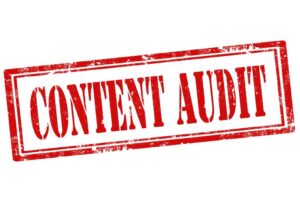A recent client meeting trip into London got me thinking about content audits again – what they can do for a business or organisation, why they happen and why ‘audits’ and ‘inventories’ are NOT the same.

And as the topic keeps coming up, I thought it might be helpful to get it all down here.
The Benefits of Content Audits
The first thing a content audit does is to show you what assets you have on hand and where you can find them. How much time and energy have you wasted looking for that article, image or PDF that you KNOW you have but can’t recall where it is or what it is linked to? I’m guessing ‘too much‘ is the most common answer.
Knowing all of that improves project planning. The more you know, the more you can plan for. If you know what you have and what state it is in – you can plan resources and timelines more accurately for work moving forward.
A content audit also gives you a baseline for assessing your overall content strategy. If we agree that a content strategy is all about what you want to accomplish and how your digital presence helps you reach your stated goals, a content audit highlights what is missing, what needs changing or updating or even removing altogether. Using the content audit in conjunction with feedback from target audiences and site stats gives you a solid foundation of information upon which to build or rebuild your digital landscape.
Reasons for a Content Audit
While one of the most common triggers for a content audit is website redesign or migration to a new platform (either as a stand-alone project or part of a larger rebranding or organisation-wide transformation), it can also be kicked off for several other reasons.
- archiving a site for removal
- implementation of new or amended template, editorial, style & meta guidelines
- to discover gaps in your content library
- establish and/or streamline production and publication processes.
When is a Content Audit Not a Content Audit
An inventory is quantitative – it’s a catalogue of assets (images, text, etc.) on hand; a snapshot of a point in time that lists material based on various attributes such as – page ID or title, URL, format, length, content owner, category, keywords, last update, etc. This can be automated to varying degrees depending on resources or software you want to bring into play.
An audit is qualitative – it evaluates that inventory based against set criteria. These can be anything from the pieces purpose, intended audience, quality & accuracy, adherence to guidelines, timeliness, usefulness, feedback, value against organisational goals & metrics, etc. This is a much more human-needed exercise as it is a decision-making process.
I have said previously – and still say today – you won’t get far without an understanding of where you’ve been, where you want to go, what you’ve got and what you still need to get there. A content audit is a road map you will need to move forward. Want to find out more about content audits and how I can help you with yours.? Get in touch – I’d be happy to walk you through it.

1 thought on “What a Content Audit Is, What It Isn’t and Why You Need One”